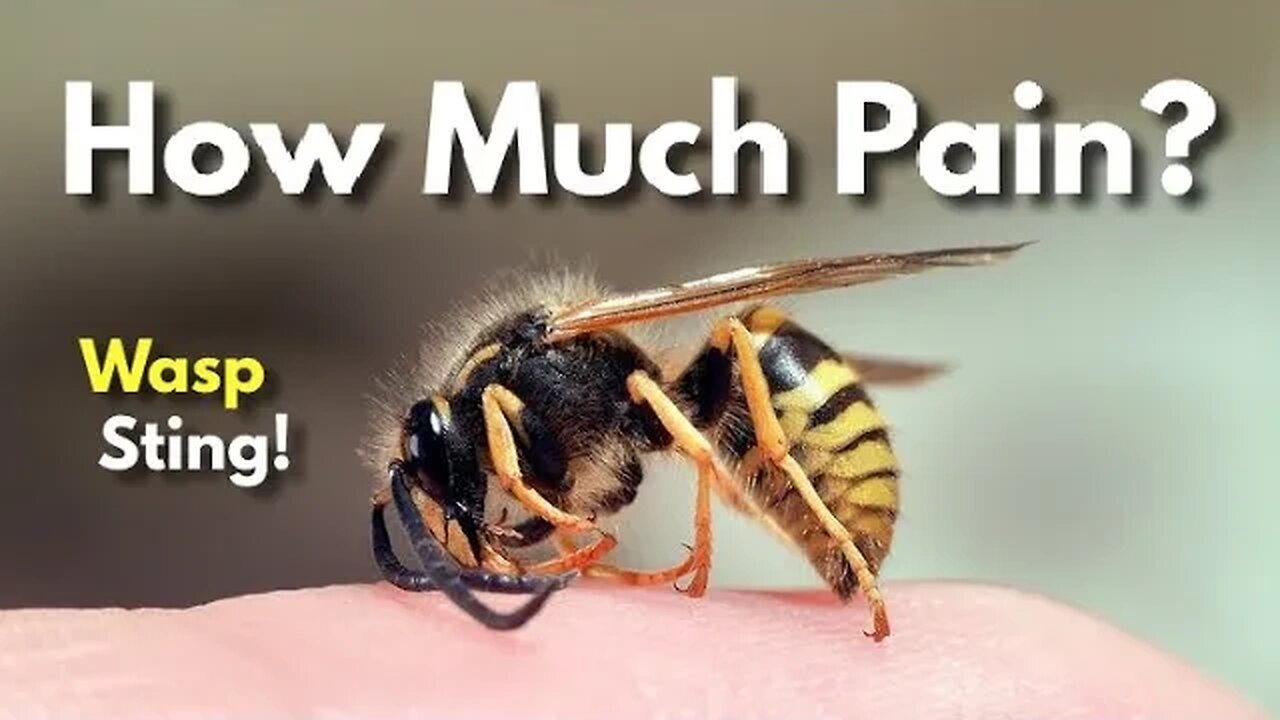Premium Only Content

How Dangerous Is A Wasp Sting? (Explained)
The Wasp, one of the most common and feared insects in the world.
But how dangerous is a wasp sting? And what should you do if you get stung?
In this video, we'll be answering these questions and more!
First of all, let's talk about the anatomy of a wasp sting. Wasps have a barbed stinger that they use to defend themselves or to capture prey. The sting is connected to a venom gland, which produces a toxic substance that is injected into the skin when the wasp stings.
Most people experience pain, redness, and swelling when they are stung by a wasp. These symptoms can be mild to moderate in severity, and they usually go away within a few hours.
Speaking about the pain of a wasp sting, let me put it in words of Justin Schmidt, A scientist who had tested a series of different insects stings in order to rate their pain ... A bit crazy but
Schmidt described the Wasp sting as “Caustic and burning. Distinctly bitter aftertaste. Like spilling a beaker of hydrochloric acid on a paper cut.
Now apart from the pain
Some people may experience more severe reactions, such as anaphylaxis, which is a life-threatening condition that can cause symptoms such as difficulty in breathing, rapid heartbeat, and swelling of the face and throat.
Now when a honey bee stings, The bees die quite a gruesome death for When the bee stings, it can’t really pull the stinger back out ... Hence the rupture of their body generally leads to their death
Whereas unlike honey bees, Individual wasps can sting repeatedly, that's because wasps don't die after stinging as their stingers are not pulled out of their bodies.
However the part that is most terrifying is when a wasp stings, its venom releases pheromones (a secreted chemical), which signal other wasps to join in the attack.
Also It might feel like it at the time, but wasps do not sting you without reason. When wasps attack, they almost always do so as a defence mechanism. This happens when people (sometimes even unknowingly) get too close to a nest.
If you get stung by a wasp, it's important to remove the stinger as soon as possible. The longer the stinger stays in the skin, the more venom it will release into your body. You can remove the stinger by gently scraping it out with a fingernail or a credit card.
After removing the stinger, you can apply a cold compress to the affected area to help reduce swelling and relieve pain. You can also take over-the-counter pain relievers, such as ibuprofen or acetaminophen, to help manage the discomfort.
Now let's talk about hornets, They belong to the wasp family. The major difference between a regular wasp and a hornets is the size and colour.
Hornets are larger and their stings are also more painful to humans than typical wasp stings because of the chemicals found in hornet venom.
However if it's a hornet or a regular wasp, it's best to keep your safe distance if you see them..
In conclusion, a wasp sting can be painful and could cause mild to moderate symptoms, but it is usually not life-threatening. However, some people may experience severe reactions, such as anaphylaxis, which can be life-threatening. If you get stung by a wasp, remove the stinger as soon as possible and seek medical attention if you experience severe symptoms.
Hope you found this video useful, Many more amazing videos on this channel. Hit the subscribe button to stay tuned!
-
 1:02:05
1:02:05
BonginoReport
3 hours agoMusic Stars Go Viral For Anti-ICE Rants - Nightly Scroll w/ Hayley Caronia (Ep.157)
29.7K26 -
 LIVE
LIVE
NostalgiaMicrodosing
2 hours agoLIVE - Digital Déjà Vu
33 watching -
 LIVE
LIVE
GritsGG
6 hours agoRANKED GRIND! Most Wins in WORLD! 3734+!
33 watching -
 1:05:06
1:05:06
TheCrucible
3 hours agoThe Extravaganza! EP: 55 with guest co-host Rob Noerr (10/16/25)
82K4 -
 1:24:30
1:24:30
Kim Iversen
4 hours agoSpotify Bans Nick Fuentes — But the Shift Can’t Be Stopped
31K54 -
 DVR
DVR
Robert Gouveia
3 hours ago🚨 John Bolton INDICTED!! Antifa Terrorists ARRESTED!! Shutdown Firings FIGHT!
25.4K6 -
 2:21:57
2:21:57
MattMorseTV
6 hours ago $74.84 earned🔴Trump's EMERGENCY Oval Office ANNOUNCEMENT.🔴
124K91 -
 1:08:13
1:08:13
Michael Franzese
4 hours agoEric Trump and Michael Franzese: When The Government Attacks Your Family (Exclusive Sitdown)
39.2K8 -
 1:20:43
1:20:43
vivafrei
6 hours agoLive with Shawn Farash! Trump Impersonator and Conservative Activist! Viva Frei Interviews!
132K43 -
 1:43:44
1:43:44
The Quartering
6 hours agoFat Acceptance Is So Over, Church Attendance Surges, Tim Pool Water, D&D Is Full Woke Trash!
140K40